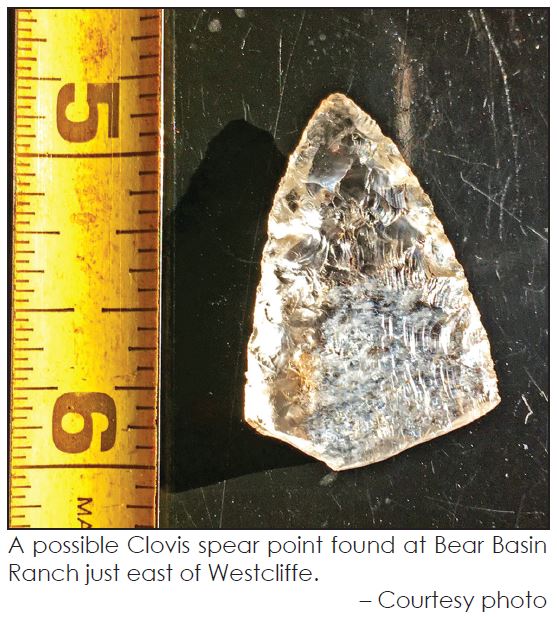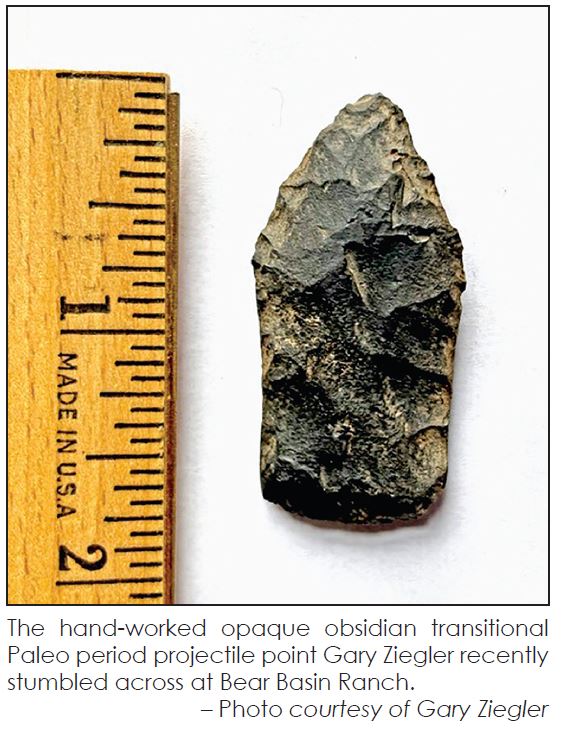While chugging along on his daily light run at Bear Basin Ranch a couple of Sundays ago, Gary Ziegler’s trained geological and archeological eye glimpsed an out-of-place small, dark object in the semi-frozen dirt amongst the flattened bush grass. Curious, he knelt, freed the tiny oblong stone, palmed it, and began to think he had come across the second ancient hand crafted stone point he has discovered at Bear Basin.
Referring to professionally and academically maintained online catalogues of these ancient remnants, Gary determined he indeed had literally stumbled upon a transitional Paleo period projectile point, shaped from opaque obsidian. (The definitive technical description of such widely scattered points, found from the plains of Minnesota to the Eastern Rockies, from Canada into northeastern Mexico, can be viewed at www.projectilepoints.net/Points/ Hell_gap.html)
He is awaiting further confirmation from his alma mater Colorado College’s Anthropology Department projectile point study specialist. In the meantime, it is fairly certain that his find could be the most ancient cultural artifact, 12,000 to 10,500 years old, reported from Custer County.
We had the pleasure to revisit the discovery site with Gary a few days ago. On a gray and wind-whipped afternoon, we drove to, and then hiked up, a small open hill towards the eastern edge of the Bear Basin property; it is situated about halfway between the 1873 ranch house in which he and his spouse, Amy Finger, live and the main ranch on the west side of County Road 271. From the mount of the hill Gary pointed out what an extraordinary, even “magic,” place it is. It overlooks three now dried but once live running drainage areas into three creeks to the north, northwest, and west. It lies just to the north of the high point of what we know as Hardscrabble Pass. When the later arriving Utes summered here, and with horses from the 1600s forward, vegetables would have been grown in the bottoms, horses grazing and corralled there as well, and the small rise on which we stood would have provided some protection from the elements.

We now also call the area Boneyard Gulch, the name originating from the first Euro-Americans settling or exploring there who discovered caches of buffalo and elk bones lying about. It had been a summer hunting ground, and would have been so 12,000 years ago as well. Gary speculates that the projectile point he found—a blade or spear point, not an arrowhead—may have been from a carcass harvested on the spot. He looked up southwesterly towards an aspen grove below, and pointing towards it mused, “Ironically I shot a rogue buffalo right there some many years ago…”
From this vantage point Gary also noted how Utes with horses would have needed better trails into the area than those that had serviced backpacks and dogs. Hence the origins of Hardscrabble Pass, the eventual stage road—there are remnants of stage stops and their horse corrals on Bear Basin Ranch—and the “road down the hill,” Highway 96, which remains to this day our only eastward connection to the Great Plains.
A “magic” place indeed…
As Gary pointed out, this is his second “lucky” discovery of an ancient cultural remnant at Bear Basin Ranch. The first was a now authenticated Folsom point, chipped from clear crystal quartz, from the same era. He plans to incorporate the details of these finds, along with the many later chips and notched arrowheads spotted, collected, and catalogued at the ranch, in a monograph on Bear Basin.
Both he and Custer County residents are grateful Gary, at the urging of a professional colleague, turned his attention to his own ranch, in addition to his exploration of the outlying villages and religious sites lying above the 15th century Inca citadel, Machu Picchu; there he had been applying his skills as mountain climber and “extreme” archeologist. Now his eyes have mentored our own, when scanning the vista from Pike’s Peak to the Sangre de Cristos, to see as the ancients saw—a vast reach of beauty and sustenance, from Tavá-Kaa-vi, Sun Mountain, to the Oquirrh, Shining Mountains.
– W.A. Ewing
Further Reading…
This is not the first spear point Gary has discovered on his ranch; he may have also discovered an extremely rare Clovis crystal point in September of 2020. Click here to read that story.


